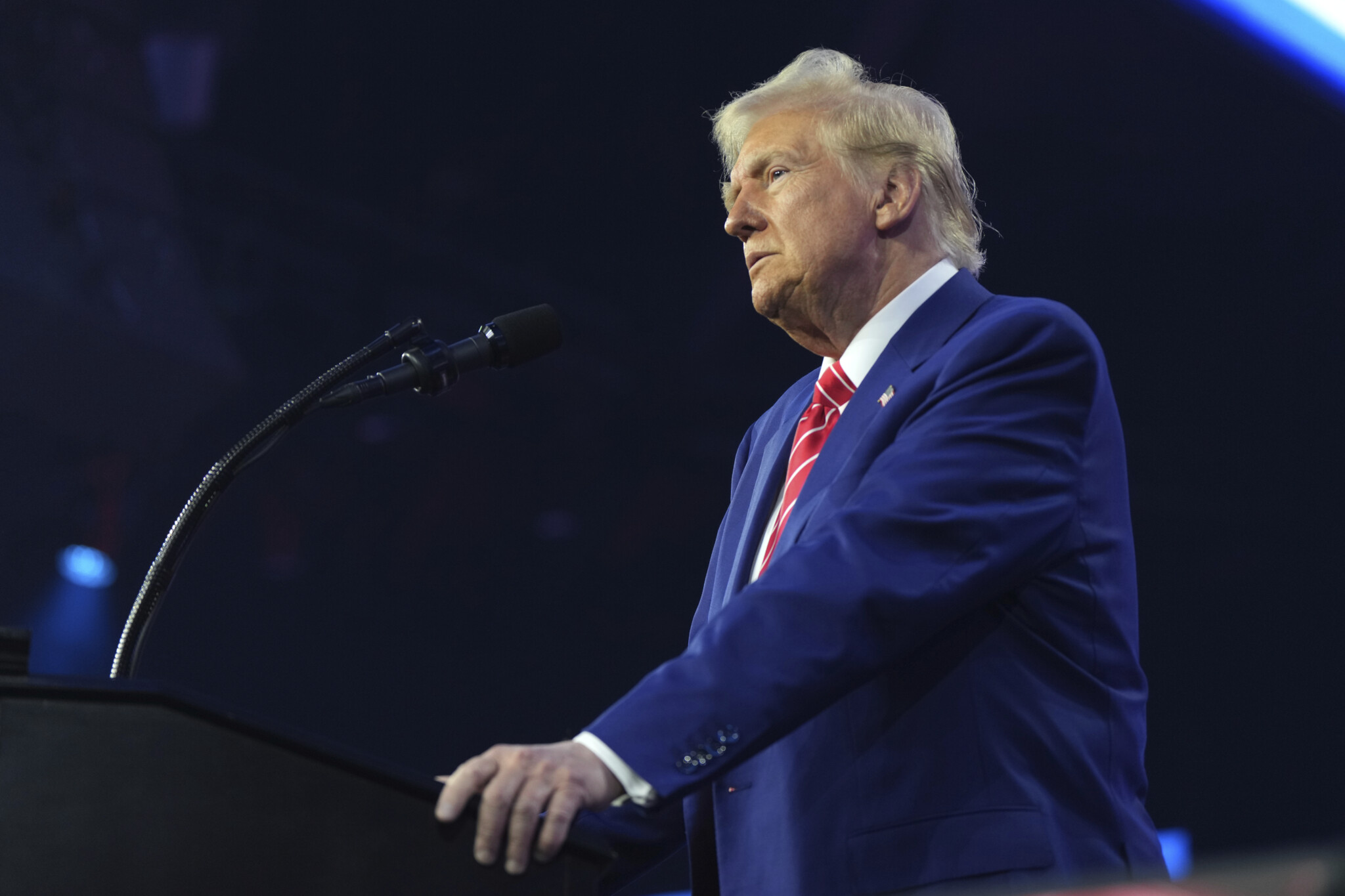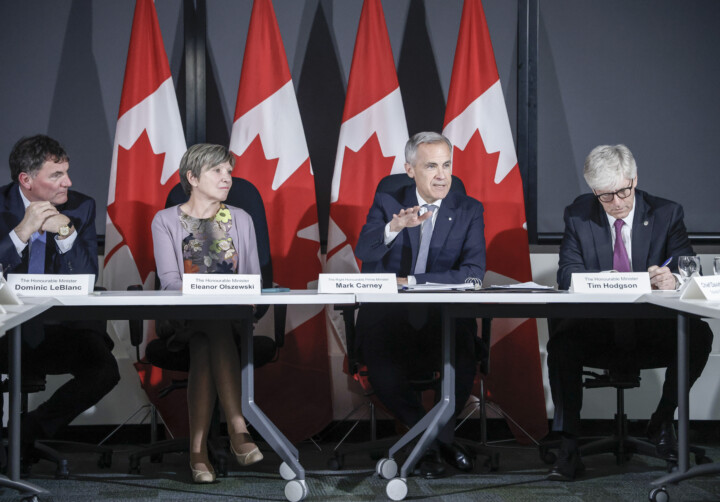‘There will be an enormous cost’: Alicia Planincic on whether Trump’s tariffs on Canada will make a bad situation worse
Publisher Rudyard Griffiths sits down with Alicia Planincic, a Hub contributor and the Business Council of Alberta’s director of policy and economics, to discuss her recent article on the U.S.-Canada trade imbalance and why it is not the economic threat that many Americans think.
The following is an automated transcript. If you are quoting from or referencing this episode, please refer to the audio to verify.
RUDYARD GRIFFITHS: Hi there. Rudyard Griffiths, the publisher of the hub. Welcome to this our occasional video interviews here in the new hub studio. I’m exceedingly pleased to be joined on our program today by Alicia Planincic. She’s the an analyst, economist, a terrific contributor here at The Hub from the Alberta Business Council. I’m sure you catch her regular economic snapshots. They’re must reads in the hub, and she joins us today from Calgary, on the eve of Monday’s inauguration of Donald Trump, where everyone is talking Tariffs and Trade. You wrote a great piece for us this week on trade, just unpacking the trade imbalance that Donald Trump is seemingly fixated on. What do you think that the President is fundamentally getting wrong right now in terms of how he’s characterizing the Canada, US trade imbalance?
ALICIA PLANINCIC: Yeah, I mean so so so much to unpack here, and this is such a big, hot topic that we’ve been talking about for a while, and I don’t think it’s going to become irrelevant anytime soon. I would say, you know, economists have long said that trade is mutually beneficial for both parties, or all parties involved, and Trump’s view of trade is actually something that can be won or lost. And when it comes to Canada, he thinks that he is losing. And the reason why he thinks he is losing is because the US has a trade deficit with Canada, which basically just means that Americans are buying more goods and products from Canada than Canadians are buying from the US, and he is correct. That is true. So there are a couple of different sources and methodologies of the data, but kind of regardless of how you look at it, he’s correct that there is a trade deficit there. He kind of throws out the number of 200 billion. It’s probably a little bit less than that, depending on your source, but it is big and it’s negative. Um, but I think what’s, what’s lost in that is a couple of things. So one, I think we forget, when we talk about trade and, you know, throw out these big billions of dollars of numbers, we kind of forget what we’re talking about, which is that trade isn’t, you know, dress Justin Trudeau and Trump kind of getting together and making a deal on who’s going to send how many cars and how many barrels of crude oil, which way or the other it is individual people and individual businesses buying things based on what’s in their best interest. And so what we’re seeing in the trade deficit really reflects what, you know, individual businesses and people buying things that they think make them better off. And one of the big things that Americans think makes them better off is buying Canadians crude oil, and so that is a huge factor in the trade deficit, and it really comes through very clearly in the chart there in the Econ minute.
RUDYARD GRIFFITHS: Yeah, let’s pull up that chart right now for our viewing audience, so people can get a sense of what this relationship looks like. And I think a critical data point that I took away from your piece, and I’d like you to explain it to our viewers today, is just how big energy factors into that trade deficit. And while you could say, hey, well, let’s take the energy out, America’s energy self sufficient, well, probably not, but there would be real costs for that energy self sufficiency. Should they give up Canadian crude and natural gas? You’ve got a number on it, so give us both those numbers that the energy.
ALICIA PLANINCIC: Yeah, yeah for sure. So Canada exports about $100 billion of crude oil to the US each year. So a huge, an enormous number, which, if you kind of square that with the trade deficit that Trump brought up, it’s basically the majority of the trade deficit is because of one single product, and that is crude oil, right? And and so I think the thing that he’s missing when he talks about trade, and we’ve talked about winning and losing, is there’s going to be an enormous cost for Americans if they were just to just dissolve this deficit, which certainly they could do. There are a number of ways that they could do it, and they could, and they could even make a trade surplus if they wanted to, but that would be a really terrible idea. The obvious cost, which, of course, lots of people have been talking about, and the immediate cost is higher price at the pumps, right? So I don’t need to go into a lecture on supply and demand to tell you that. You know, if you cut off crude oil imports for the US, then you’re going to increase prices at the pump, right? So ultimately, they’re going to try to fill that gap by probably producing more domestically and maybe importing more from other countries to the extent that they can, but there’s very clearly going to be a higher price that Americans pay at the pump, and Americans really do not like to pay higher prices at the pump. That’s a very important political consequence of this decision. But I think the other consequence and something that has been a. Little bit lost is the fact that if, if the US were to sort of close the gap on this, so if the US were to produce all the things domestically that they’re currently buying from Canada, which they could do fine, but they would ultimately have to divert their resources away from what they’re currently doing. And arguably, what economists would say is they’re more productive use, right? So things that the US is is currently really good at doing and produce a lot of wealth for them. Ultimately, they’d have to cut back on that just in order to produce all the things that they’re currently buying from Canada. And that’s really where we see the impact, not just on consumer prices, but on American incomes.
RUDYARD GRIFFITHS: Yeah, such a great point. I mean, this is the lovely invisible hand of trade. That means that countries apply their productive labour, their productive capital, to things that other people want. And let’s just end on that point, because I think it’s something that your article brings up, that we should all remember, is that nobody’s holding a gun to each other’s heads when we trade. We trade because we’re trying to match wants and needs. We’re trying to match, you know, what you can produce and what I can produce, and come to some kind of sense that there are things that you’re going to do better than I’m going to do, and vice versa. And that’s all okay at the end of the day. In fact, that’s how things should work. That makes for more efficient, productive and wealthy economies.
ALICIA PLANINCIC: That’s a great point to end on. I couldn’t have said it better myself.
RUDYARD GRIFFITHS: Well, look, thank you so much for your contributions to The Hub. I want to encourage readers to get onto our website this week. Check out Alicia’s piece with us at triple w the hub.ca. And go to the Alberta Business Council, where she provides all kinds of terrific insight and analysis on Canadian economics, energy, you name it, visit the Alberta Business Council for more commentary, thoughts and opinions. Thanks so much for coming on the program today. Let’s catch up again soon.
ALICIA PLANINCIC: Thanks so much.



